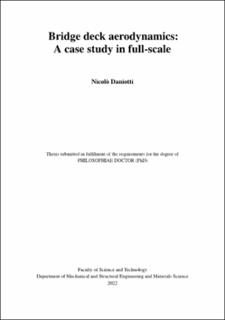| dc.description.abstract | One of the key aspects of bridge deck aerodynamics is the transformation of the incident wind flow into fluctuating surface pressures around a bridge deck. The atmospheric turbulence generates fluctuating loads on bridge decks, i.e. the buffeting wind action. The state-of-the-art knowledge about bridge deck aerodynamics, as well as the bases for the design of long-span bridges, relies primarily on wind-tunnel testing. By contrast, full-scale studies concentrating on the surface pressure distributions around bridge girders are rare. The central thrust of this work is to develop an experimental setup to investigate the aerodynamics of a closed-box girder bridge deck in full-scale.
A bespoke pressure measuring system is designed and developed to monitor wind-induced surface pressures around three chords of the Lysefjord Bridge in Norway, previously instrumented by a number of wind and vibration sensors. The one- and two-point statistics of the undisturbed turbulence are simultaneously measured, thereby facilitating the study of the spatial structure of the gust loading in the atmosphere. The experimental setup is aided by 3D sonic anemometers placed within the disturbed flow regions, upstream of the bridge deck nose and in the near wake.
The overall distortion of the atmospheric turbulence induced by the bridge deck body is examined, as well as the related vortex shedding process. In particular, the flow in the near-wake region of the bridge deck is investigated, in both model- and full-scale. For skewed incident winds, the near-wake flow exhibits highly three-dimensional features, including a significant axial flow on the leeward side of the full-scale bridge deck. Also, the frequency-dependent energy redistribution within the near wake is examined with emphasis on wavelengths associated with the periodic formation of vortex structures. The Strouhal number associated with the deck cross-section studied is found to be similar in both full- and model-scale. The turbulence level in the inflow is found to impact significantly the value of the non-dimensional vortex shedding frequency in full-scale. Specifically, the higher the turbulence intensity, the higher the Strouhal number. Lastly, the “anatomy” of the vortex shedding
process is described based on the surface pressure measurements undertaken on the trailing edges of the deck.
Investigating the gust loading generation in full-scale is central to this research. Fluctuating drag, lift and twisting moment are estimated on three chord-wise strips, based on a limited number of pressure sensing points. The analysis of the monitored surface pressures underpins the limits of the strip assumption in modelling the correlation along the bridge span of the lift and moment. Specifically, the span-wise coherence of the turbulence-driven lift and moment is observed to be higher than the span-wise coherence of the incident vertical velocity fluctuations. This result, which is deemed original given its full-scale framework, is in an overall agreement with the wind tunnel studies focusing on the gust loading on motionless section models of closedbox girder bridge decks. Also, a pronounced amplification of the vertical velocity fluctuations is observed upstream of the bridge deck nose, thereby providing a link between the undisturbed turbulence and the resulting gust loading on the deck.
Keywords: Bridge deck aerodynamics, Full-scale, Wind turbulence, Nearwake flow, Wind buffeting, Surface pressure measurements | en_US |
